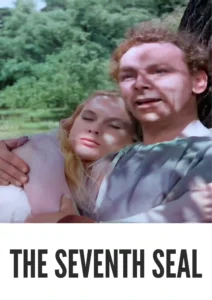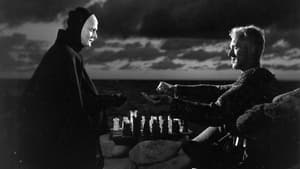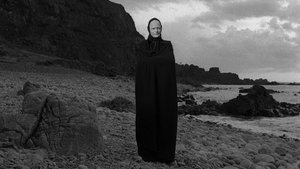Video Sources 0 Views
- Watch trailer
- The Seventh Seal 1957 Colorized


Synopsis
Table of Contents
Toggle
Embark on a philosophical journey through the stark landscapes of medieval Sweden with Ingmar Bergman’s iconic film, The Seventh Seal, now vividly colorized for a modern audience. Released in 1957, this cinematic masterpiece delves into profound questions of life, death, and faith, all while following the gripping tale of a knight playing a chess game against Death himself. This HD download offers a fresh perspective on a timeless classic, blending Bergman’s artistic vision with contemporary visual enhancements. Perfect for cinephiles and those seeking thought-provoking cinema, this colorized version invites a new generation to explore the depths of human existence.
The Seventh Seal unfolds during the Black Death in 14th-century Sweden. Antonius Block (Max von Sydow), a weary knight, returns home after a decade spent in the Crusades to find his country ravaged by plague and despair. Confronted by Death (Bengt Ekerot), who has come to claim him, Block proposes a game of chess, hoping to buy time to perform a meaningful act and find answers to his existential questions.
As the game progresses, Block encounters a traveling family of actors, Jof (Nils Poppe), Mia (Bibi Andersson), and their infant son, whom he sees as symbols of hope and innocence in a world consumed by darkness. His interactions with them, as well as with other characters he meets along his journey, lead him to contemplate the nature of faith, doubt, and the human condition. The film is rich with symbolism and allegorical imagery, creating a powerful and moving exploration of mortality and the search for meaning. The Seventh Seal is a cinematic tour de force that continues to resonate with audiences worldwide.
The Seventh Seal features a stellar cast of Swedish actors who bring depth and nuance to their roles:
-
Max von Sydow as Antonius Block, the Knight
-
Bengt Ekerot as Death
-
Nils Poppe as Jof, the actor
-
Bibi Andersson as Mia, Jof’s wife
-
Gunnar Björnstrand as Jonas Skat, the actor
The Seventh Seal transcends traditional genre classifications, but it is often described as an existential art house drama. It combines elements of historical drama with philosophical inquiry, exploring themes of mortality, faith, and the human condition in a visually striking and emotionally resonant manner.
Released in 1957, The Seventh Seal marked a significant turning point in Ingmar Bergman’s career, solidifying his status as one of the world’s most influential filmmakers. The film was produced during a period of artistic flourishing in Swedish cinema, and it helped to bring international attention to the country’s rich cinematic tradition. The Seventh Seal is a landmark achievement that continues to be studied and admired for its innovative storytelling, striking visuals, and profound philosophical themes.
This colorized version of The Seventh Seal has been carefully crafted to enhance the visual experience while remaining true to the film’s original artistic intent. Modern digital techniques were employed to add color to the black and white footage, with careful attention given to recreating the atmosphere and mood of each scene. The colorization process involved extensive research into the historical context of the film, ensuring that the colors used were appropriate for the time period and setting. The goal was to bring new life to the characters and landscapes, making the film more accessible to contemporary audiences while preserving its artistic integrity. While the colorization of classic films remains a topic of debate, this version of The Seventh Seal offers a unique opportunity to experience Bergman’s masterpiece in a fresh and engaging way.
-
: Ingmar Bergman
-
: Ingmar Bergman
-
: Gunnar Fischer
-
: Lennart Wallén
-
: Svensk Filmindustri
-
: Svensk Filmindustri
-
: 96 minutes
-
: Det sjunde inseglet (original Swedish title)
-
: MP4
-
: HD (1080p)
-
: Compatible with most devices, including smartphones, tablets, computers, and smart TVs.
The Seventh Seal (1957) is widely regarded as one of Ingmar Bergman’s greatest films and a cornerstone of world cinema. Its profound themes, striking visuals, and powerful performances have earned it numerous accolades and a lasting legacy. The film continues to be studied and celebrated for its exploration of existential questions and its innovative approach to storytelling. As a timeless masterpiece, The Seventh Seal remains a profound and moving cinematic experience.
-
: What is The Seventh Seal about?
-
A: The Seventh Seal is a philosophical drama about a knight who plays a game of chess with Death during the Black Death.
-
-
: Is The Seventh Seal (1957) a well-known Bergman film?
-
A: Yes, The Seventh Seal is one of Bergman’s most famous and influential works.
-
-
: Is this version of The Seventh Seal colorized?
-
A: Yes, this version has been professionally colorized to enhance the viewing experience.
-
-
: What makes The Seventh Seal important?
-
A: The Seventh Seal is a landmark film that explores profound themes of mortality, faith, and the human condition.
-
-
: What is the download format?
-
A: The download format is MP4, which is compatible with most devices.
-
-
: What resolution is the download?
-
A: The resolution is HD (1080p), providing a high-quality viewing experience.
-
Watch The Seventh Seal Today!




















